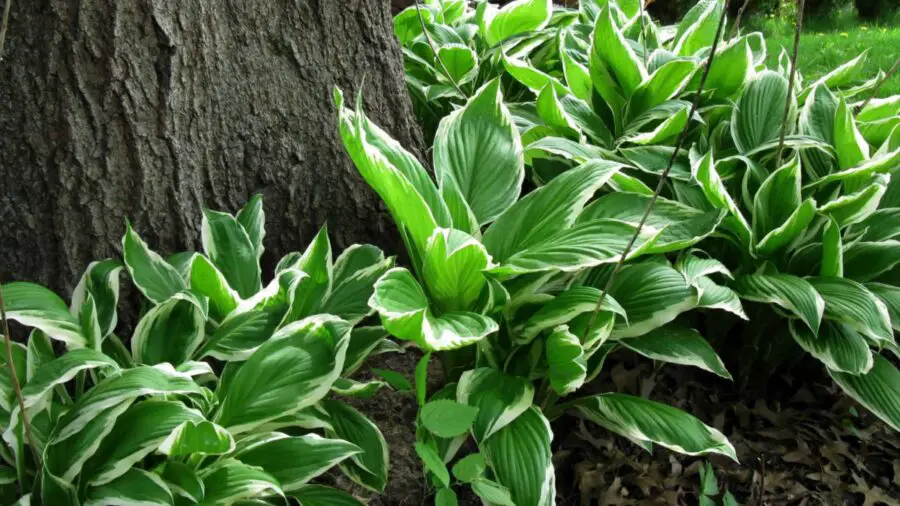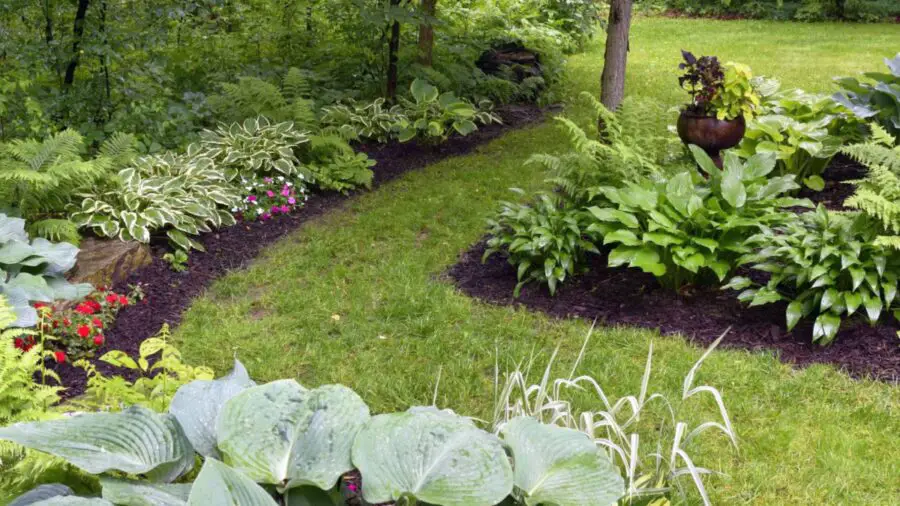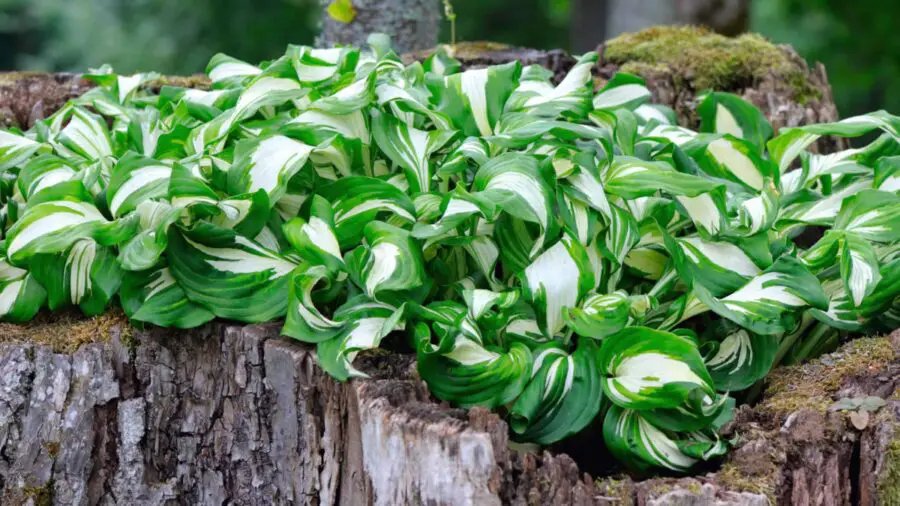You most likely know that hostas do very well growing in partial shade, and different species and cultivars thrive in USDA hardiness zones 3 to 9 .
Therefore, it’s possible to grow hostas under trees, as I’ve found out over the years. The trees and hostas can compete for water, but this is a relatively easy fix. The trees provide shade to prevent your hostas from getting too much sun.
If you’re like me, you have trees all over your yard, and this used to be a problem with trying to find plants that grow well shaded by them. I wondered how to plant hostas under trees years ago, so I did a little digging (book digging).
Looking to see if you could put hostas under trees, no matter which trees you had in your yard. I also wanted to see what differences you ran into when planting hostas under trees versus planting them in shaded areas.
I’m excited to share my results with you to help you keep your hostas thriving. So, let’s dive in!
Why Plant Hostas Under Trees
If a hosta gets too much sun, it won’t grow as well because these are shade-loving plants. Most hostas do like dappled sunlight, as long as you can avoid the hot afternoon temperatures.
So certain types of trees can be perfect. They offer enough protection from the sun for your hostas to thrive, but they let some sunlight through so the hostas will grow well.

Hostas under trees can look very nice in your yard, and I know I love how certain cultivars fill in nicely and add pops of color. However, when you consider planting hostas under trees, you want to make sure that it’s a tree species that won’t work against the hosta.
I do not recommend some species of trees when wanting the best hosta growth, and they can even smother out healthy plants.
I’m going to outline a few of the best trees to consider (and some to avoid!) when you’re considering planting hostas under trees next.
Notes About Planting Hostas Under Specific Trees
Not all trees are suited for hostas. Will hostas grow under pine trees? How about oak trees or cedar trees? Maybe you have pine or maple trees in your yard that you want to fill in with hostas.
The last thing you want to do is plant a hosta and watch it slowly dwindle away, and so choosing the correct tree species is so important.
Hostas Under Maple Trees
Do hostas grow under maple trees? Many people will tell you no. First, maple tree roots can form what some people call an impenetrable mat. This can make it next to impossible for your hosta’s root system to grow properly, and the plant can start dwindling away from lack of nutrients.
Maple tree roots are also very fine, and these tiny roots are the feeder roots. They’ll go right through your hosta’s root zone and work to steal the plant’s water and nutrients.
This can slowly cause the hosta to wither away year after year until it eventually dies unless you remove it.
If you really want some hostas under a maple tree I would suggest using containers. on top of the ground or dug in an inch or two for a more cohesive look. Time to go shopping for more pots.
Hostas Under Pine Trees
Will hostas grow under pine trees? The short answer is yes and no. When you plant hostas under pine trees, you risk subjecting them to competition with the tree’s root system for nutrients and water.
The thicker canopy of this tree will also block a large majority of the water and sun. You could also easily damage the tree’s root system when you plant your hostas under trees.
Pine trees drop a lot of needles. If you get a heavy layer of these needles, it can easily smother any hostas underneath it.
Pine needles make a good mulch, but you can damage your hostas trying to clear out the pine needles too. Therefore, you’ll be better off to avoid planting around them.
Yes, you can plant hostas under pine trees and using a few simple techniques you can be successful growing hostas under your pine trees.
Hostas Under Oak Trees
Oak trees have broad limbs with stout trunks that make them an ideal candidate to plant your hostas underneath. They also have a deeper root system that won’t form a mat or compete with your hosta roots for nutrients.
There are both evergreen and deciduous oak trees available, so some will drop their leaves and some will keep them.
Oak trees drop their leaves, so take time to clean out around your hostas so they don’t get buried under a thick blanket.
If they do, this can directly affect how healthy your plants are and how they come back next season. If you get it right, your yard will look like mine and have lush plants surrounding the tree’s base.
Hostas Under Cedar Trees
As long as you have true cedar trees in your yard, like red cedar or Himalayan cedar, you can plant hostas under cedar trees without a problem.
The tree will provide enough shade to keep the hosta happy, and the hosta can act like a guard for the tree to keep things like lawn mowers or string trimmers away from the trunk.
However, some trees that people mistake for true cedars will secrete a chemical from their roots. This chemical is toxic to many plants, and it’s a trait called allelopathy.
If you have true cedars, they have antimicrobial properties in their roots to help resist rot, and this won’t harm your hostas.
Thujone is another chemical that cedars secrete that helps to repel insects, and this could benefit your hostas under cedar trees by providing protection.
Hostas Under Spruce Trees
I have spruce trees in my area, and so far, it’s been a mixed bag of success and failure when I plant hostas under spruce trees. For one, these types of trees can form a thicker canopy that doesn’t allow as much light through to reach the hostas.
The bigger problem is that spruce is very good at quickly sucking up every drop of nutrients and moisture, and this is difficult for hostas to compete with.
However, with spruce trees, dig down between the roots and plant your hosta there. Keep in mind that they’ll still compete for water and nutrients, and they won’t get as big as they traditionally would.
However, I’ve noticed that this method gives them a fighting chance to come back year after year.
Hostas Under Dogwood Trees
Dogwood trees grow thick trunks with slightly thicker canopies, so be aware of this when you pick out your hosta cultivars. They’ll get more shade than sun under this tree, but there won’t be as much competition for water or nutrients.
Yes, I know dogwood trees have smaller feeder roots. However, they’re good for hostas because most of the root system goes deeper into the ground. This allows the hostas to pull nutrients in water in without competing with the tree.
If you water them enough, you can easily keep the soil slightly moist. Combine this with shade, and you have the perfect conditions for planting hostas under trees.
Hostas Under Poplar Trees
Can you plant hostas under poplar trees and have them do well? Again, the answer is yes and no. Poplar trees rarely spread out as much as other tree species, so your hostas may not get as much shade.
To combat this, plant hostas that do well with slightly more sun. The tree can shade them from the harshest sunlight of the day.
Poplar trees have a very extensive but shallow root system that could compete with your hostas for water and nutrients. They usually have deeper roots right by the trunk, so it’s a good idea to get your hostas as close to it as possible.
I’ve found that digging down and putting the hostas between the larger roots gives them enough of an edge to do well.
Hostas Under Ash Trees
Ash trees are ones you want to avoid when you’re considering areas for planting hostas under trees.
One big reason for this is that it puts out a lot of very fine and dense roots. These roots make it difficult for the hosta to establish its own root system, and it can take away necessary nutrients and water.
Also, the ash tree can attract the emerald ash borer . This is a destructive pest that can wreak havoc on the tree itself and any surrounding plants.
Your hostas can already be weak because of completion, and these pests can kill your hostas. The soil and trunk injections used to treat this pest are an unknown quality regarding your hostas.
How to Plant Hostas Under Trees—Step by Step

So, you’ve picked out a tree or trees for your hostas to grow under. Now, how do you plant them so they grow and thrive? I’ve found out that you will have to do a little more work when you’re planting hostas under trees to ensure they grow well. The basic steps are:
Step One—Pick Smaller Plants
The primary goal with this project is to protect the tree roots while giving your hostas enough room for their roots to spread out. To do this, I’ve found that the best course of action is to pick out hostas in small containers or plants that have bare roots.
This will allow you to get closer to the tree without having to dig a massive hole and disturb the roots.
You will most likely see the smaller feeder roots, and you may even break some as you plant your hostas. However, these feeder roots will come back quickly.
You’re mostly worried about cutting or injuring the tree’s bigger roots. Some trees also have roots that are barely below the surface, and it can negatively affect the tree when you disturb them.
Step Two—Start Digging Slightly Away from the Tree’s Trunk
You don’t want to put your hostas right tight to the tree’s trunk, despite what many people may think. Instead, you want to give the tree at least 12 inches of space.
You should get a trowel and dig a small hole that is just large enough for your hosta’s root ball or roots. You can also use a digging knife.
If you run into a slightly bigger root, it’s best to move your hosta to another spot to avoid issues down the road. You also want to avoid damaging any of the bark at your tree’s base.
If you do, this can invite pests and diseases inside the tree, and this can lead to tree death.
Also, don’t ring the tree with your plants. Instead, fill in around it. It’ll look much more natural if you have hostas growing at various points close to the tree than it will if you try to fill in every piece of space around the tree.
This can lead to crowding, and your hostas may not do as well.
Step Three—Test and Amend the Soil
I’ve found that many hosta species are relatively hardy. But, in order to give your hostas the best shot possible of establishing and growing, you’ll want to test and amend your soil before you plant them.
For the perfect conditions, you want your soil to be slightly acidic, organic, and drain freely. They like a very fertile mix that gives them a lot of nutrients.
The soil around your tree should also be able to hold water without water logging the root system. There’s a good chance you’ll need to amend your soil to reach these requirements. You can add peat moss, Douglas fir bark, or pumice.
Ideally, your pH levels will fall between 6.5 and 7.5. If it falls below or above this range, you’ll have to amend it . If you want to lower your pH in the soil, you can add sulfur for a slow-release solution or aluminum sulfate for an immediate one.
Raising the pH will involve adding limestone. Bigger pieces will work best for a longer period while small chunks will work faster and break down quicker.
Step Four—Plant Your Hostas
Once you have the correct soil conditions, you want to place your hosta in when you’re planting hostas under trees. Gently backfill the soil so the plant ends up at the same depth as it was in the pot.
If you picked out bare-root plants, set them with the crown at the soil’s level. The growing tips should be left exposed.
Give it a light water so the soil compresses and then add more soil as needed until you fill the hole. Don’t press the soil down or make it every compact.
Hosta roots like to spread out horizontally along the surface of the soil. Make sure you space your additional plants according to their mature size so they don’t get too crowded and compete.
Step Five—Mulch and Fertilize
It’s important that you add a two-inch layer of mulch around your new hostas. Mulch will help keep weeds out, and it also helps the soil retain moisture each time you water.
Monitor your soil moisture more closely here because the hostas and trees compete for it. Adding a drip irrigation system is a good choice, and I like it because it allows you to add water right to the root ball without adding too much to the tree.
Most hostas do remarkably well with a 10-10-10, slow release fertilizer. You should never apply over one pound of fertilizer for every 100 square feet, as they don’t need a lot.
I like to apply fertilizer once during the end of March or start of April and again in the middle of June. This gives the plant a boost of nutrients it needs to establish itself and grow.
Frequently Asked Questions
Will Hostas Be Okay If You Plant Them Under Trees
When planting hostas under trees, they can do very well if you plant them under the correct type of tree. Dogwood, poplar, cedar, and oak are safe choices. You should avoid pine trees, ash, spruce, and non-true cedar trees.
How Far Away Should the Hostas Be from the Tree
You don’t want to make the mistake of planting your hostas right tight to the tree. This increases the chances of them competing with thicker root systems and you could damage the bark. Keep them around a foot away from the trees.
Should Your Hostas Be Tight Together
No, when planting hostas under trees, space them just like you would normally space them out. They should be as far apart as the plant will be wide at maturity. So, if your hosta is listed as 15-inches wide, they should be at least 15-inches apart.
Closing Thoughts

So, can you plant hostas under trees? Now you know you can, provided that you follow a few simple steps and avoid certain trees.
If you get it right, you could transform your yard like I did. You’ll end up with lush foliage all spring and summer long, and the hostas and trees will both be able to grow and thrive without too much competition.